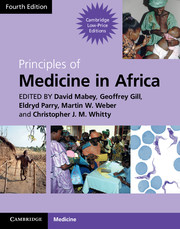Book contents
- Frontmatter
- Contents
- Contributors
- Foreword
- Section 1 Health and disease
- Section 2 Mother and child health
- 5 The pregnant patient
- 6 Neonatal care
- 7 The integrated management of childhood illness (IMCI)
- 8 Severe acute malnutrition in childhood
- 9 Diarrhoea
- 10 Pneumonia and other acute lower respiratory tract infections in children
- 11 Measles
- 12 Pertussis
- Section 3 Infection: general principles
- Section 4 Major common infections
- Section 5 Bacterial infections
- Section 6 Viral Infections
- Section 7 Protozoal infections
- Section 8 Helminth infections
- Section 9 Fungal infections
- Section 10 Non-communicable diseases
- Section 11 Diseases of body systems
- Section 12 Cancer and Palliative Care
- Section 13 Venoms and Poisons
- Index
- References
9 - Diarrhoea
from Section 2 - Mother and child health
Published online by Cambridge University Press: 05 March 2013
- Frontmatter
- Contents
- Contributors
- Foreword
- Section 1 Health and disease
- Section 2 Mother and child health
- 5 The pregnant patient
- 6 Neonatal care
- 7 The integrated management of childhood illness (IMCI)
- 8 Severe acute malnutrition in childhood
- 9 Diarrhoea
- 10 Pneumonia and other acute lower respiratory tract infections in children
- 11 Measles
- 12 Pertussis
- Section 3 Infection: general principles
- Section 4 Major common infections
- Section 5 Bacterial infections
- Section 6 Viral Infections
- Section 7 Protozoal infections
- Section 8 Helminth infections
- Section 9 Fungal infections
- Section 10 Non-communicable diseases
- Section 11 Diseases of body systems
- Section 12 Cancer and Palliative Care
- Section 13 Venoms and Poisons
- Index
- References
Summary
Definitions
Diarrhoea is the passage of loose or watery stools at least three times in 24 hours (WHO, 2005c). In acute diarrhoea the illness lasts less than 14 days. Dysentery is diarrhoea with visible blood in the stool. Persistent diarrhoea is diarrhoea that begins acutely and lasts at least 14 days. These conditions differ with regard to pathogenesis, treatment and risk of death.
The problem in Africa
In Africa, children below age 3 years experience about three to ten episodes of diarrhoea each year and may spend 10–15 per cent of their days with diarrhoea (Kosek et al., 2003). World-wide, about 1.7 million children below age 5 years die each year from diarrhoea (WHO, 2008). Acute diarrhoea causes about 80 per cent of diarrhoea episodes and 50 per cent of deaths. Dysentery causes about 10 per cent of diarrhoea episodes and 15 per cent of deaths whilst persistent diarrhoea causes about 10 per cent of episodes and 35 per cent of deaths.
The incidence of diarrhoea may vary markedly with season; outbreaks of acute diarrhoea due to rotavirus infection, in particular, tend to occur in well-defined epidemics (Fig. 9.1).
Diarrhoea is also common in African adults. Cholera epidemics have occurred in many countries in recent years (see Chapter 33) and outbreaks of bacillary dysentery, often resistant to multiple antibiotics, have caused many deaths. Chronic diarrhoea or ‘slim disease’ is a major feature of adult HIV disease.
- Type
- Chapter
- Information
- Principles of Medicine in Africa , pp. 113 - 123Publisher: Cambridge University PressPrint publication year: 2013

